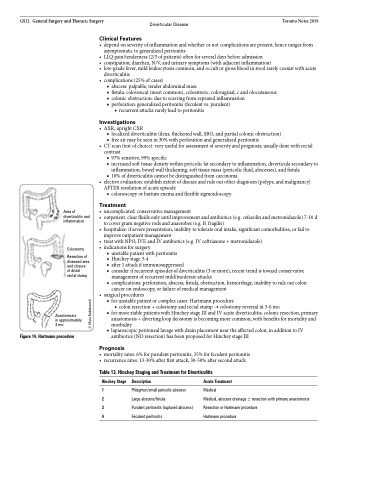Page 434 - TNFlipTest
P. 434
GS32 General Surgery and Thoracic Surgery Diverticular Disease Toronto Notes 2019
Area of diverticulitis and inflammation
Colostomy
Resection of diseased area and closure of distal rectal stump
Anastomosis
in approximately 3mo
Figure 14. Hartmann procedure
Clinical Features
• dependonseverityofinflammationandwhetherornotcomplicationsarepresent;hencerangesfrom asymptomatic to generalized peritonitis
• LLQpain/tenderness(2/3ofpatients)oftenforseveraldaysbeforeadmission
• constipation,diarrhea,N/V,andurinarysymptoms(withadjacentinflammation)
• low-gradefever,mildleukocytosiscommon,andoccultorgrossbloodinstoolrarelycoexistwithacute
diverticulitis
• complications(25%ofcases)
■ abscess: palpable, tender abdominal mass
■ fistula: colovesical (most common), coloenteric, colovaginal, c and olocutaneous ■ colonic obstruction: due to scarring from repeated inflammation
■ perforation: generalized peritonitis (feculent vs. purulent)
◆ recurrent attacks rarely lead to peritonitis
Investigations
• AXR,uprightCXR
■ localized diverticulitis (ileus, thickened wall, SBO, and partial colonic obstruction) ■ free air may be seen in 30% with perforation and generalized peritonitis
• CTscan(testofchoice):veryusefulforassessmentofseverityandprognosis;usuallydonewithrectal contrast
■ 97%sensitive,99%specific
■ increased soft tissue density within pericolic fat secondary to inflammation, diverticula secondary to
inflammation, bowel wall thickening, soft tissue mass (pericolic fluid, abscesses), and fistula ■ 10% of diverticulitis cannot be distinguished from carcinoma
• electiveevaluation:establishextentofdiseaseandruleoutotherdiagnoses(polyps,andmalignancy) AFTER resolution of acute episode
■ colonoscopy or barium enema and flexible sigmoidoscopy
Treatment
• uncomplicated:conservativemanagement
• outpatient:clearfluidsonlyuntilimprovementandantibiotics(e.g.cefazolinandmetronidazole)7-10d
to cover gram negative rods and anaerobes (e.g. B. fragilis)
• hospitalize:ifseverepresentation,inabilitytotolerateoralintake,significantcomorbidities,orfailto
improve outpatient management
• treatwithNPO,IVF,andIVantibiotics(e.g.IVceftriaxone+metronidazole)
• indicationsforsurgery
■ unstable patient with peritonitis
■ Hinchey stage 3-4
■ after 1 attack if immunosuppressed
■ consider if recurrent episodes of diverticulitis (3 or more), recent trend is toward conservative
management of recurrent mild/moderate attacks
■ complications: perforation, abscess, fistula, obstruction, hemorrhage, inability to rule out colon
cancer on endoscopy, or failure of medical management
• surgicalprocedures
■ for unstable patient or complex cases: Hartmann procedure
◆ colon resection + colostomy and rectal stump → colostomy reversal in 3-6 mo
■ for more stable patients with Hinchey stage III and IV acute diverticulitis, colonic resection, primary anastomosis + diverting loop ileostomy is becoming more common, with benefits for mortality and morbidity
■ laparoscopic peritoneal lavage with drain placement near the affected colon, in addition to IV antibiotics (NO resection) has been proposed for Hinchey stage III
Prognosis
• mortalityrates:6%forpurulentperitonitis,35%forfeculentperitonitis • recurrencerates:13-30%afterfirstattack,30-50%aftersecondattack
Table 13. Hinchey Staging and Treatment for Diverticulitis
Hinchey Stage
1 2 3 4
Description
Phlegmon/small pericolic abscess Large abscess/fistula
Purulent peritonitis (ruptured abscess) Feculent peritonitis
Acute Treatment
Medical
Medical, abscess drainage ± resection with primary anastomosis Resection or Hartmann procedure
Hartmann procedure
© Myra Rudakewich


